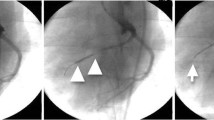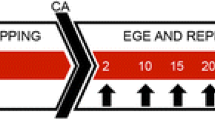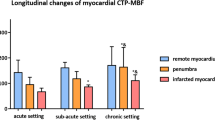Abstract
To quantify, using MRI, the acute impacts of defined volume and sizes of coronary microemboli on myocardial viability and left ventricular (LV) function and to use LAD occlusion/reperfusion, as a reference. A total of 28 farm pigs were used in this study. Eight animals were used as controls. Successful coronary interventions were performed under X-ray fluoroscopy in 16 pigs to induce microinfarct (delivery of 16 mm3 of 40–120 μm) and large infarct (90 min LAD occlusion/reperfusion). On day 3, animals were imaged using contrast enhanced (in beating and non-beating hearts) and cine MRI for evaluating LV viability and function, respectively. Microscopy and cardiac injury enzymes were used to confirm the presence of necrosis. Myocardial damage was smaller after microembolization than occlusion/reperfusion (6.5 ± 0.6 %LV mass vs. 12.6 ± 1.2 %, P < 0.001). The increase in LV end-systolic volume and decreases in ejection fraction, cardiac output and regional systolic wall thickening, however, were comparable between groups, but significantly differed from controls. MRI also demonstrated microvascular obstruction after microembolization and occlusion/reperfusion as hyperenhanced and hypoenhanced regions, respectively. Microscopic examination revealed patchy necrosis, inflammatory cell infiltration, but no intramyocardial hemorrhage after microembolization and extensive intramyocardial hemorrhage and transmural damage in the occlusion/reperfusion group. Cardiac injury enzymes confirmed presence of myocardial damage in animals with interventions. Coronary microemboli have acute impact on LV function compared to control animals. Despite the difference in myocardial damage, global and regional LV dysfunction after microembolization was comparable to occlusion/reperfusion. This MR study suggests that the pattern of myocardial damage plays a role in LV dysfunction.





Similar content being viewed by others

References
Frink RJ, Rooney PA Jr, Trowbridge JO, Rose JP (1988) Coronary thrombosis and platelet/fibrin micro emboli in death associated with acute myocardial infarction. Br Heart J 59:196–200
Jaffe R, Dick A, Strauss BH (2010) Prevention and treatment of microvascular obstruction-related myocardial injury and coronary no-reflow following percutaneous coronary intervention: a systematic approach. JACC Cardiovasc Interv 3:695–704
Kwong RY, Chan AK, Brown KA, Chan CW, Reynolds HG, Tsang S, Davis RB (2006) Impact of unrecognized myocardial scar detected by cardiac magnetic resonance imaging on event-free survival in patients presenting with signs or symptoms of coronary artery disease. Circulation 113:2733–2743
Anderson JL, Adams CD, Antman EM, Bridges CR, Califf RM, Casey DE Jr, Chavey WE II, Fesmire FM, Hochman JS, Levin TN, Lincoff AM, Peterson ED, Theroux P, Wenger NK, Wright RS, Smith SC Jr, Jacobs AK, Adams CD, Anderson JL, Antman EM, Halperin JL, Hunt SA, Krumholz HM, Kushner FG, Lytle BW, Nishimura R, Ornato JP, Page RL, Riegel B (2007) Acc/aha 2007 guidelines for the management of patients with unstable angina/non-st-elevation myocardial infarction: a report of the american college of cardiology/american heart association task force on practice guidelines (writing committee to revise the 2002 guidelines for the management of patients with unstable angina/non-st-elevation myocardial infarction) developed in collaboration with the american college of emergency physicians, the society for cardiovascular angiography and interventions, and the society of thoracic surgeons endorsed by the american association of cardiovascular and pulmonary rehabilitation and the society for academic emergency medicine. J Am Coll Cardiol 50:e1–e157
Klem I, Shah DJ, White RD, Pennell DJ, van Rossum AC, Regenfus M, Sechtem U, Schvartzman PR, Hunold P, Croisille P, Parker M, Judd RM, Kim RJ (2011) Prognostic value of routine cardiac magnetic resonance assessment of left ventricular ejection fraction and myocardial damage: an international, multicenter study. Circ Cardiovasc Imaging 4:610–619
Selvanayagam JB, Porto I, Channon K, Petersen SE, Francis JM, Neubauer S, Banning AP (2005) Troponin elevation after percutaneous coronary intervention directly represents the extent of irreversible myocardial injury: insights from cardiovascular magnetic resonance imaging. Circulation 111:1027–1032
Prasad SB, See V, Brown P, McKay T, Narayan A, Kovoor P, Thomas L (2011) Impact of duration of ischemia on left ventricular diastolic properties following reperfusion for acute myocardial infarction. Am J Cardiol 108:348–354
Wu KC, Zerhouni EA, Judd RM, Lugo-Olivieri CH, Barouch LA, Schulman SP, Blumenthal RS, Lima JA (1998) Prognostic significance of microvascular obstruction by magnetic resonance imaging in patients with acute myocardial infarction. Circulation 97:765–772
Schwartz RS, Burke A, Farb A, Kaye D, Lesser JR, Henry TD, Virmani R (2009) Microemboli and microvascular obstruction in acute coronary thrombosis and sudden coronary death: relation to epicardial plaque histopathology. J Am Coll Cardiol 54:2167–2173
Carlsson M, Jablonowski R, Martin AJ, Ursell PC, Saeed M (2011) Coronary microembolization causes long-term detrimental effects on regional left ventricular function. Scand Cardiovasc J 45:205–214
Carlsson M, Martin AJ, Ursell PC, Saloner D, Saeed M (2009) Magnetic resonance imaging quantification of left ventricular dysfunction following coronary microembolization. Magn Reson Med 61:595–602
Carlsson M, Saloner D, Martin AJ, Ursell PC, Saeed M (2010) Heterogeneous microinfarcts caused by coronary microemboli: evaluation with multidetector ct and mr imaging in a swine model. Radiology 254:718–728
Saeed M, Hetts SW, Do L, Wilson M (2011) Mri study on volume effects of emboli on myocardial function, perfusion and viability. Int J Cardiol. doi:10.1016/j.ijcard.2011.07.096
Saeed M, Hetts SW, English J, Do L, Wilson MW (2011) Quantitative and qualitative characterization of the acute changes in myocardial structure and function after distal coronary microembolization using mdct. Acad Radiol 18:479–487
Saeed M, Hetts SW, Ursell PC, Do L, Kolli K, Wilson M (2012) Evaluation of the acute effects of distal coronary microembolization using multidetector computed tomography and magnetic resonance imaging. Magn Reson Med 67(6):1747–1757. doi:10.1002/mrm.23149
Indik JH, Allen D, Gura M, Dameff C, Hilwig RW, Kern KB (2011) Utility of the ventricular fibrillation waveform to predict a return of spontaneous circulation and distinguish acute from post myocardial infarction or normal swine in ventricular fibrillation cardiac arrest. Circ Arrhythm Electrophysiol 4:337–343
Yilmaz A, Rosch S, Klingel K, Kandolf R, Helluy X, Hiller KH, Jakob PM, Sechtem U (2011) Magnetic resonance imaging (mri) of inflamed myocardium using iron oxide nanoparticles in patients with acute myocardial infarction: preliminary results. Int J Cardiol. PMID:21689857
Heiberg E, Ugander M, Engblom H, Gotberg M, Olivecrona GK, Erlinge D, Arheden H (2008) Automated quantification of myocardial infarction from mr images by accounting for partial volume effects: animal, phantom, and human study. Radiology 246:581–588
Reimer KA, Jennings RB (1979) The “wavefront phenomenon” of myocardial ischemic cell death. Ii. Transmural progression of necrosis within the framework of ischemic bed size (myocardium at risk) and collateral flow. Lab Invest 40:633–644
Ma JY, Qian JY, Jin H, Chen ZW, Chang SF, Yang S, Sun AJ, Zeng MS, Zou YZ, Ge JB (2009) Acute hyperenhancement on delayed contrast-enhanced magnetic resonance imaging is the characteristic sign after coronary microembolization. Chin Med J (Engl) 122:687–691
Doize F, Deroth L (1991) Identification by isoelectric focusing of creatine kinase-mm isoforms in the plasma and striated muscle of pigs. Vet Res Commun 15:279–284
Okamura A, Ito H, Iwakura K, Kawano S, Inoue K, Maekawa Y, Ogihara T, Fujii K (2005) Detection of embolic particles with the doppler guide wire during coronary intervention in patients with acute myocardial infarction: efficacy of distal protection device. J Am Coll Cardiol 45:212–215
Balian V, Galli M, Marcassa C, Cecchin G, Child M, Barlocco F, Petrucci E, Filippini G, Michi R, Onofri M (2006) Intracoronary st-segment shift soon after elective percutaneous coronary intervention accurately predicts periprocedural myocardial injury. Circulation 114:1948–1954
Breuckmann F, Nassenstein K, Bucher C, Konietzka I, Gernot Kaiser G, Konorza T, Naber C, Skyschally A, Gres P, Heusch G, Erbel R, Barkhausen J (2009) Systematic analysis of functional and structural changes after coronary microembolization: a cardiac magnetic resonance imaging study. J Am Coll Cardiol Img 2:121–130
Galiuto L, Crea F (2006) No-reflow: a heterogeneous clinical phenomenon with multiple therapeutic strategies. Curr Pharm Des 12:3807–3815
Mohlenkamp S, Beighley PE, Pfeifer EA, Behrenbeck TR, Sheedy PF II, Ritman EL (2003) Intramyocardial blood volume, perfusion and transit time in response to embolization of different sized microvessels. Cardiovasc Res 57:843–852
Malek LA, Spiewak M, Klopotowski M, Misko J, Ruzyllo W, Witkowski A (2012) The size does not matter: the presence of microvascular obstruction but not its extent corresponds to larger infarct size in reperfused stemi. Eur J Radiol 81(10):2839–2843
Dorge H, Schulz R, Belosjorow S, Post H, van de Sand A, Konietzka I, Frede S, Hartung T, Vinten-Johansen J, Youker KA, Entman ML, Erbel R, Heusch G (2002) Coronary microembolization: the role of tnf-alpha in contractile dysfunction. J Mol Cell Cardiol 34:51–62
Erbel R, Heusch G (2000) Coronary microembolization. J Am Coll Cardiol 36:22–24
Zhang QY, Li JB, Wang ZH, Li XB, Yin LH, Wei M (2010) Tranilast stabilizes the accumulation and degranulation of resident mast cells while reducing cardiomyocyte apoptosis in a swine model of coronary microembolisation. Clin Exp Pharmacol Physiol 37:641–646
Charron T, Jaffe R, Segev A, Bang KW, Qiang B, Sparkes JD, Butany J, Dick AJ, Freedman J, Strauss BH (2010) Effects of distal embolization on the timing of platelet and inflammatory cell activation in interventional coronary no-reflow. Thromb Res 126:50–55
Stone GW, Webb J, Cox DA, Brodie BR, Qureshi M, Kalynych A, Turco M, Schultheiss HP, Dulas D, Rutherford BD, Antoniucci D, Krucoff MW, Gibbons RJ, Jones D, Lansky AJ, Mehran R (2005) Distal microcirculatory protection during percutaneous coronary intervention in acute st-segment elevation myocardial infarction: a randomized controlled trial. JAMA 293:1063–1072
Conflict of interest
None.
Author information
Authors and Affiliations
Corresponding author
Rights and permissions
About this article
Cite this article
Saeed, M., Hetts, S.W., Do, L. et al. Mri quantification of left ventricular function in microinfarct versus large infarct in swine model. Int J Cardiovasc Imaging 29, 159–168 (2013). https://doi.org/10.1007/s10554-012-0076-7
Received:
Accepted:
Published:
Issue Date:
DOI: https://doi.org/10.1007/s10554-012-0076-7



